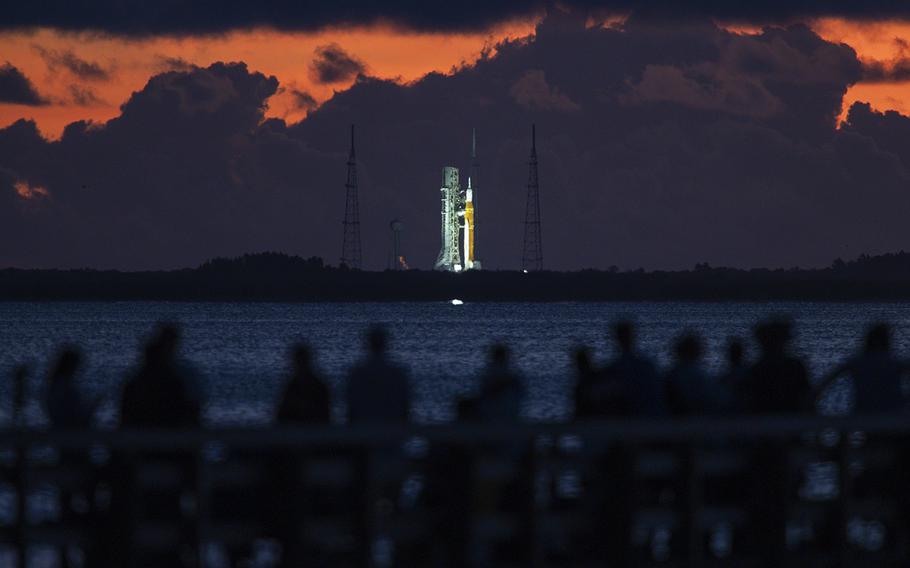
The Space Launch System rocket sits on the launch pad at NASA’s Kennedy Space Center Launch Complex 39B as spectators wait across the water at Rotary Riverfront Park in Titusville, hoping to see NASA’s Artemis I mission launch. (Ivy Ceballo/TNS)
TITUSVILLE, Fla. (Tribune News Service) — The space nerds poured into town by the thousands in NASA T-shirts, booking every last hotel room but leaving them empty. Instead they double-parked on roadsides and bridges, pitched prohibited tents in parks and slept in running cars. Diehards staked spots along the banks of the Indian River a full day early.
Lit up across the dark water, stood what would be the most powerful rocket ever to fly, waiting to propel NASA’s Artemis I mission to the moon.
The vibe at Rotary Riverfront Park was like a tailgate before a big game, with charged-up fans in team gear spouting surprisingly technical armchair analysis. Midnight fell, and they kept vigil in camp chairs under a sliver of crescent moon, discussing the sound of liftoff, the clouds of Venus, the nighttime lows on Mars.
Joey Vars, an earnest 29-year-old with long hair shaved on the sides, waited in his favorite spot where the launchpad peeked between the palms. He had driven from St. Petersburg playing his usual soundtrack, the Public Service Broadcasting album “The Race For Space.” His best friend, Michael Strittmatter, rode shotgun, his boyfriend, Paul Scribner, in back. Now they drank Artemis Pale Ale and watched space news on YouTube.
Morning, Vars hoped, would bring his 42nd launch, according to a list in his journal with entries starting October 1997: John Glenn’s space shuttle ride at age 77. Vars had been making this pilgrimage since he was 5.
“Before it was trendy,” he said. “I can’t go too long without a launch.”
The Artemis missions, aiming to return humans to the moon and set the table for Mars, are a big deal in an already booming new era for the space industry in Florida. And like previous moonshots, the Space Coast is ground zero for liftoff and the nation’s attention. For hardcore space fans, it’s the place to be.
“It’s just this incredible technical power you’re witnessing, this feat of engineering,” Vars said. But it’s also a tradition, a “history of people gathering together on this river to watch these rockets, going back to Apollo.”
Space and history are an apex of his interests. As the historian at the Belleview Inn in Belleair, Vars leads tours of the 19th-century hotel. He’s also curator of the Gulfport Historical Society, with a beach apartment filled with hundreds of books, four out of five about space.
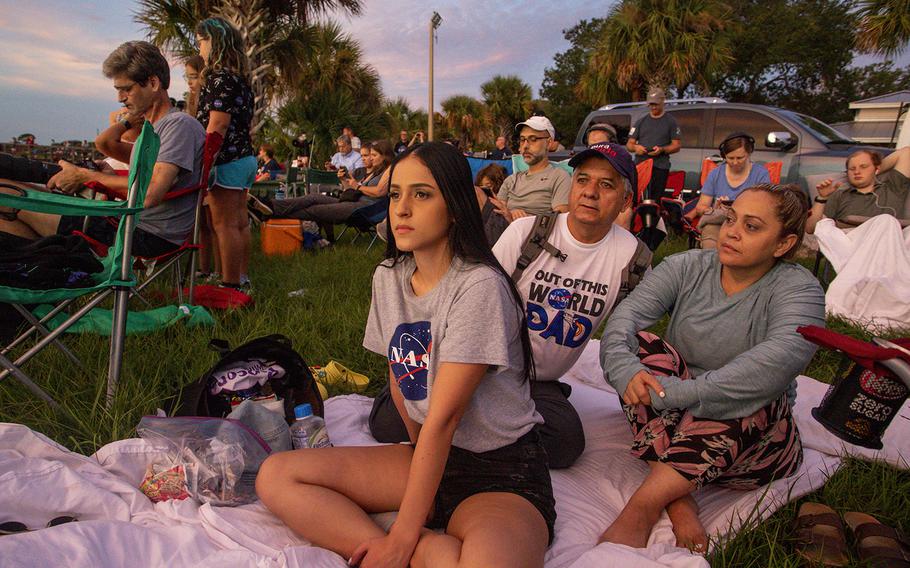
Joselyn Guerrero, 22, Alex Guerrero, 54 and Margo Castro, 51, of Costa Rica, await the launch of the Artemis rocket with others from Rotary Riverfront Park in Titusville on Aug. 29, 2022. NASA scrubbed the launch following an engine issue. (Ivy Ceballo/TNS)
What is it about launches? The glory of human achievement? The catharsis of liftoff, of escape? Maybe it’s something more mystical. “It can get emotional,” Vars managed.
To illustrate, a beaming Scribner pulled out his phone to play a favorite video. Vars stares at the sky after SpaceX’s first crewed launch in 2020, the one the internet dubbed the “Bob and Doug” launch. He’s speechless, and when he looks toward the camera, his eyes are full of tears.
Lots of people cry at launches, it turns out. As morning broke, the space nerds crowded the park waiting for that feeling.
Huntsville, Alabama, may be the “Rocket City” where scientists built America’s first spacecrafts. Houston, aka “Space City,” owns NASA Mission Control. But Florida is where the candle gets lit.
Years ago, Neil deGrasse Tyson argued that Kennedy Space Center should be Florida’s biggest attraction, not the theme parks. Asked recently, former astronaut Bruce Melnick agreed.
“It’s real simple,” Melnick said. “Disney is all make-believe, and at Kennedy Space Center, you’re walking into reality.”
Melnick, who with Nicole Stott is one of two astronauts to graduate from Clearwater High School, has witnessed 70 launches up close. “And I’ve had a tear in my eye for every one of them except the ones I was in.”
Space fans feel the Space Coast’s pull.
The eve of Artemis I’s planned launch, a bar in Cocoa hosted a gathering of the Planetary Society. Founded by Carl Sagan and now led by Bill Nye, it is to space enthusiasts what the Audubon Society is to birders.
Mary Bowling, 67, mingled with members in town from Baltimore and Thailand. Bowling had worked at Kennedy Space Center in the 1980s as a computer operator, but she left when the job was eliminated following the Challenger disaster. Decades later, after retirement and a divorce, she was wistful.
“I remembered how I used to see the astronauts, like Sally Ride, running around, and I kept thinking about how Kennedy was the best job I ever had,” she said. “I decided to come back here, just to be near all this again.”
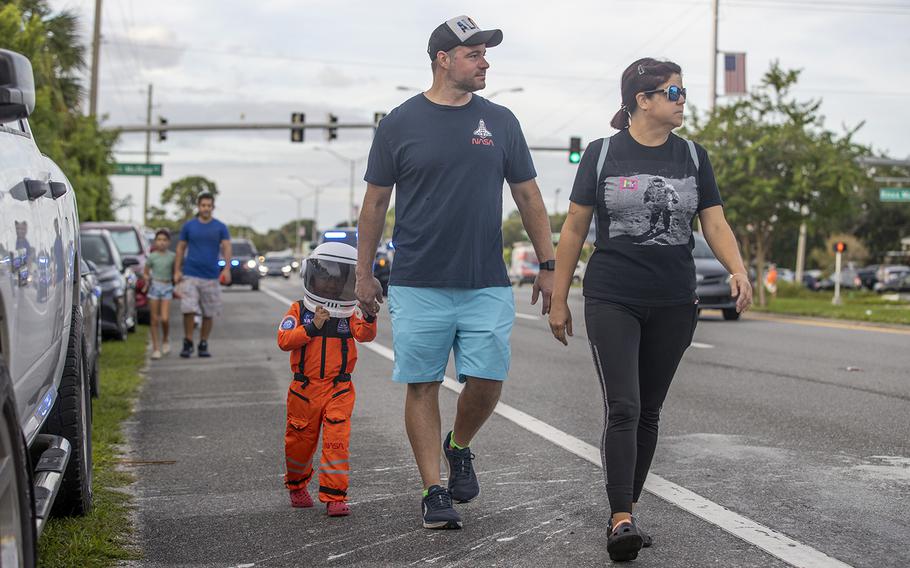
Nathaniel Lopez, 3, holds hands with his uncle, Ryan Lopez, 43, and his mother Angela Lopez, 43, outside Rotary Riverfront Park in Titusville. NASA scrubbed the launch of Artemis I following an engine issue. (Ivy Ceballo/TNS)
Strangers wearing the same “Get Your Ass to Mars” T-shirt bonded over IPAs.
“Space people really are my favorite people,” said Sarah Al-Ahmed, seated at the bar.
Some said they love how space is not politicized, or caught in the culture wars, or tainted by “bad news.” That is, of course, not exactly true. There are questions about Congress’ funding of Artemis to please special interests when the project is billions over budget, with 1970s tech soon to be surpassed by cheaper SpaceX options. Then there’s the legacy of the space race as patriotic propaganda. There have always been people who ask, reasonably, why we spend so much on space when so much is wrong on Earth.
St. Petersburg’s Emily Carney, founder of the group Space Hipsters and blogger for a company that sends human ashes to space, doesn’t disagree. She was uneasy herself with how the focus on the “Bob and Doug” SpaceX flight was “America’s return to space,” because “space is for everyone.” But she went to see that launch, and went back hoping to see Artemis.
“It’s about exploring places we’ve never seen,” she said of Artemis, an entrée to deeper space. “It’s like the spirit of Apollo again, except Apollo was all white guys. I love the Apollo astronauts, but Artemis is going to lead to the first woman on the moon, and the first people of color, and actually be representative of humanity.”
Every Floridian should experience a launch, she said. After all, “space is interwoven in Florida’s history.”
After a brilliant orange and purple sunrise on Aug. 29, the two-hour window for the Artemis launch approached. The crowd at the riverfront park streamed NASA updates and scrolled space Twitter.
In the crowd was a Virginia dad who had pulled his kids from school, retirees from California trying to catch a launch after a long-ago miss, a local construction worker who had ridden out his first launch decades ago atop a suddenly vibrating roof in Titusville.
Atop the nearby Marriott, the Space Bar was packed with employees of NASA contractor Lockheed Martin. In a Merritt Island backyard, “booster brats,” as some offspring of Apollo and shuttle workers call themselves, gathered to party. Off the Atlantic coast, a St. Petersburg resident captained a boat for fans who’d paid $99 for an unobstructed view.
“The vice president’s plane just landed,” someone in the park announced.
Then word spread from Twitter to the crowd. An engine wasn’t getting cold enough during the hydrogen chilling process. NASA paused the countdown. A few minutes later, yelling erupted: “It’s a scrub!”
People packed up their cars and their kids as fast as they could. Then they sat in a traffic jam, as unmoving as the rocket.
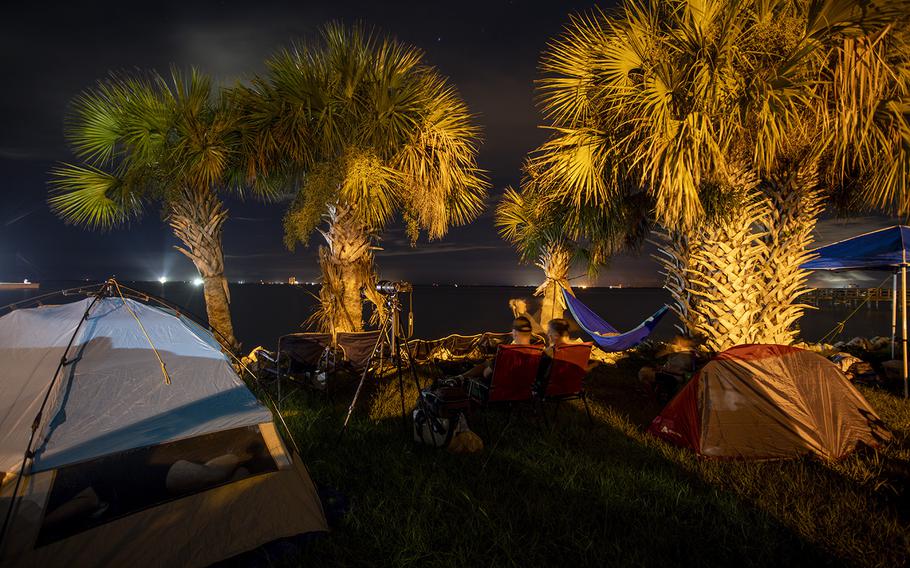
Visitors camp overnight at Rotary Riverfront Park to watch the Artemis I launch in Titusville on Aug. 29, 2022. (Ivy Ceballo/TNS)
Vars was unbothered.
The scrub just meant another day to geek out with his people. His best friend, whom he’d first spotted at the University of South Florida wearing a NASA shirt, was at his side, and so was his boyfriend, who once wasn’t a space person, but now was on his seventh launch.
Best of all, because NASA would try again in five days, he had an excuse to come back.
America’s earliest space launches caught Floridians by surprise, if they noticed at all. Brevard County was a sparse region of sandy coastal scrub and citrus groves. Missiles took flight from desolate Cape Canaveral unannounced, as secret military operations.
Things were far different by 1961, when NASA launched Alan Shepard into space with live coverage and thousands of spectators camped on Cocoa Beach with beer and sandwiches.
By 1968, when Apollo 8 launched three men on a mission to orbit the moon, hundreds of thousands of people were causing traffic the Brevard sheriff described as eight hours of hell. Florida Today wrote of homes burning down during launches with firefighters stuck in gridlock.
Neighborhoods rose to accommodate Apollo workers, making Brevard America’s fastest-growing county of the era. Meanwhile, Cocoa Beach became the backdrop of 1960s TV hit “I Dream of Jeannie,” about a genie wedded to an astronaut. Today new generations of space workers live in those same homes on Pluto Street and Uranus Avenue, dotted with “I’m Part of Artemis” yard signs.
Rather than the futuristic spaceport one might have predicted in the ’60s, though, the region looks more like undeveloped stretches of scrub oaks and sabal palms. Bald eagles and wild boars populate the massive wildlife refuge surrounding Kennedy Space Center. Still, driving U.S. Route 1, the coastal sprawl features spacey trimmings: a rocket-shaped sign at the CBD store, a model space shuttle at a city hall, the chain of banks named Launch: “Ignite Your Savings!”
“At night the pool areas of the motels became like the roaring fraternity lounge of Project Mercury,” Tom Wolfe wrote of Cocoa Beach’s 1960s astronaut hijinx in “The Right Stuff,” but at the address of the old Starlite Motel, where astronaut Gordon Cooper supposedly dumped live fish in the pool, there’s a Hilton.
The Chevy dealership that leased every Mercury astronaut a new Corvette for $1 is now a storage lot.
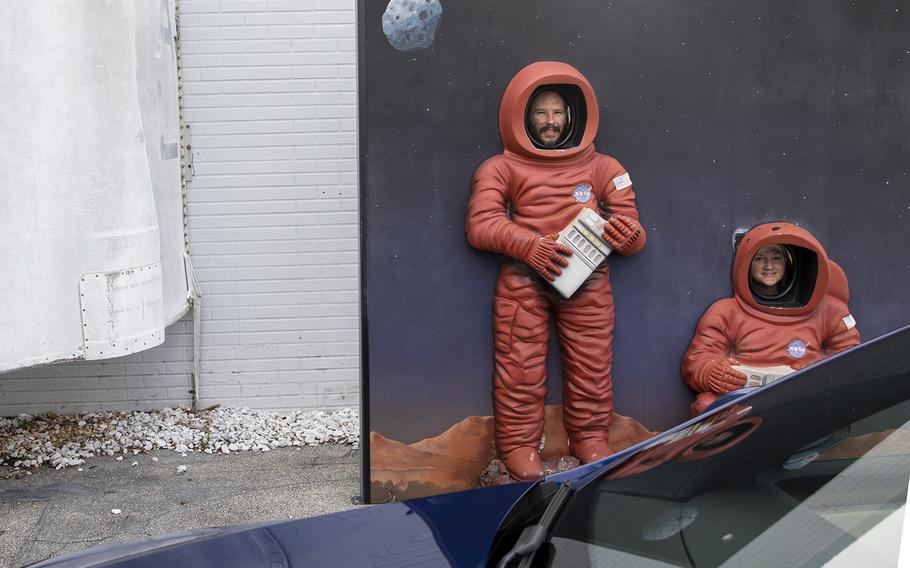
Robert Streicho, 42, and Mary Kathleen Bryan, 45, of Nashville, pose for a picture outside of the American Space Museum in Titusville. (Ivy Ceballo/TNS)
History was better preserved in a blockhouse at the Cape Canaveral Space Force Station complete with a 50s-era launch control room: built-in ashtrays, a thousand blinking lights and less computing power than your refrigerator.
A bit down the road was the abandoned missile silo where the wreckage of the Space Shuttle Challenger is buried. No photos allowed.
More than America’s 400-some, mostly Houston-based astronauts, the exhibits conjured Florida’s behind-the-scenes employees. Tens of thousands have worked in the space industry around Cape Canaveral, and it feels like everyone in town has a connection.
The hotel desk clerk was the daughter of a NASA engineer. The American Space Museum’s office manager is a former Kennedy Space Center paramedic. Her son, a welder, works nearby at SpaceX. A visitor browsing near John Glenn’s hardhat recalled her uncle’s days as a diver retrieving jettisoned shuttle boosters from the Atlantic.
And the 94-year-old volunteer taking tickets at another small museum, the Sands Space History Center, was would-be astronaut Al Crews. Twice selected to go to space, he saw both programs, the X-20 space plane and the Manned Orbiting Lab, get scrapped.
“You meet people like that all the time around here,” said Heather Scott, chief of communications for the Space Force unit that controls Cape Canaveral. “You’re walking among giants and don’t even know it.”
For 60 years, the local economy has followed the fortunes of the space program to some degree. Locals described abandoned homes after the Apollo program ended in the 1970s, owners leaving keys on counters, notes reading, “please take over the payments.”
Quiet years returned after the shuttle program ended in 2011, before commercial space companies like SpaceX and Blue Origin and a dozen others got rolling. Now there’s about a launch per week from Florida, already a record-setting year with 34 and counting.
The boom is back. Local realtors described handing keys to new space workers, more of whom appear to arrive every day.
Five days later, on Sept. 3, NASA was ready to try launching Artemis I again.
Joey Vars, Paul Scribner and Michael Strittmatter woke up around 4 a.m. in St. Petersburg, packed the cooler and headed east.
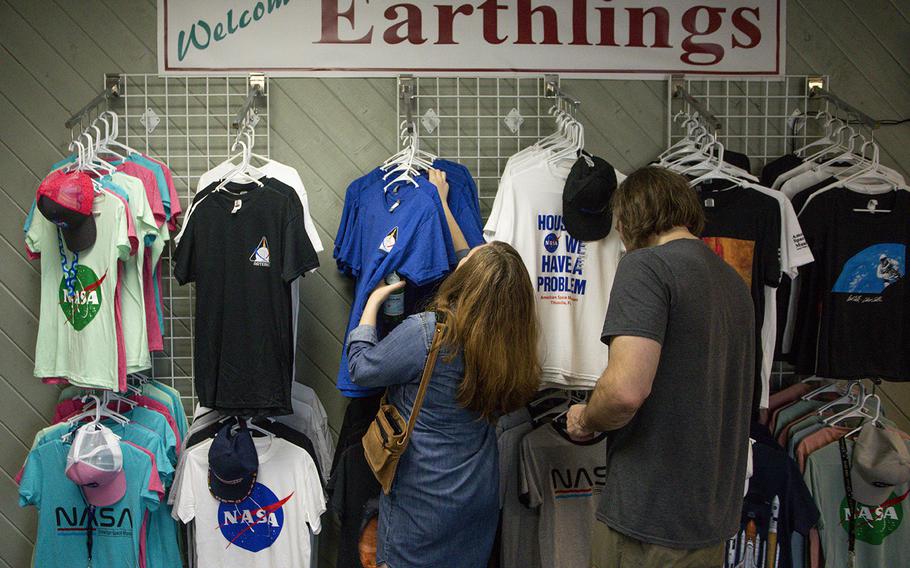
Mary Kathleen Bryan, 45, and Robert Streicho, 42, of Nashville, shop for souvenirs after visiting the American Space Museum in Titusville in August 2022. (Ivy Ceballo/TNS)
It was quiet, and they saw the sun rise as they passed through Orlando. “This is Florida at its best,” Vars thought. News of a hydrogen leak came while they were still on the road, a dash of uncertainty.
Once again the Titusville T-shirt vendors were out hawking and the hotels were full up. Restaurants were charging $30 for parking, advertising something called “moon milk,” and the parks were crowded when Vars arrived.
Around 9 a.m. the leak remained unresolved. Vars has been doing this long enough. When a third attempt at a fix didn’t take, he looked for an exit plan.
As he pulled into Playalinda Brewery in search of one last Artemis Ale with his friends, the official announcement came: another scrub.
Those who’d stayed packed up, disappointed, sure, but not altogether unhappy. “I got to meet all these nice people and talk space,” said Oveido’s John MacDonald, “and I’m not usually a social person.”
Vars wasn’t mad either. He sipped beer, surrounded by dozens of people who’d made the same trip for the same experience.
“Sharing it with each other reminds us of our common goals as humans,” he wrote in a journal later. “And, for some, our pride in being Floridians.”
The Artemis program is a stepping stone to humans on Mars. Some wonder if that trip will happen within our lifetime. Vars will gladly come back in a month hoping to see the next step.
If you go
NASA plans to launch Artemis I on Tuesday, Sept. 27. The 70-minute launch window begins at 11:37 a.m. NASA has set a backup launch date of Oct. 2. The launch can be watched live at nasa.gov/nasalive.
A calendar of other launches from Kennedy Space Center and Cape Canaveral, including SpaceX and United Launch Alliance rockets, is available at spacecoastlaunches.com/launch-schedule.
The best viewing area for Space Coast launches is along the Indian River waterfront from Titusville to Cocoa, and Cocoa Beach north to Cape Canaveral. Some popular viewing spots include Rotary Riverfront Park, Space View Park and Kennedy Point Park in Titusville, and Jetty Park in Port Canaveral. A map of viewing locations is available at visitspacecoast.com/launches.
©2022 Tampa Bay Times.
Visit tampabay.com.
Distributed by Tribune Content Agency, LLC.